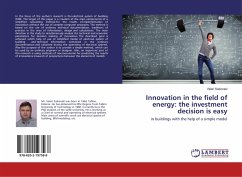
Innovation in the field of energy: the investment decision is easy
in buildings with the help of a simple model
Versandkostenfrei!
Versandfertig in 6-10 Tagen
24,99 €
inkl. MwSt.

PAYBACK Punkte
12 °P sammeln!
In the focus of the author's research is the electrical system of building (ESB). The target of this paper is a creation of the main components of a simplified calculating method for the results of implementation of innovation without the use of complex computer programs. The method is based on the use of ordinary technical documentation, traditions of practice in the area of information, design and calculations. The main direction in the study to simultaneously analyze the technical and economic parameters for decision making of innovation. The described goal is achieved whith help of use of ...
In the focus of the author's research is the electrical system of building (ESB). The target of this paper is a creation of the main components of a simplified calculating method for the results of implementation of innovation without the use of complex computer programs. The method is based on the use of ordinary technical documentation, traditions of practice in the area of information, design and calculations. The main direction in the study to simultaneously analyze the technical and economic parameters for decision making of innovation. The described goal is achieved whith help of use of simplified model of electrical system of building and technical information contained in the ordinary documentation and obtained during the operating of electrical systems. Also the purpose of the author is to provide a simple method, which can be used by an ordinary engineer or designer. Also, an important part of this research is using methods of macroeconomic for predicting the results ofinnovations (research of proportions between the elements of model).












